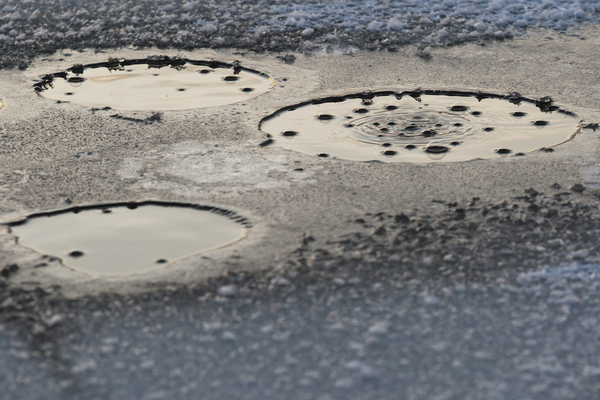Another guest post from George Leopold:
An increasingly likely “methane pulse” that would result from the warming of Arctic permafrost will have dire economic consequences as grave as the climatic impact. So warn a trio of European researchers specializing in ocean physics and the economic impact of climate change.
They calculate in a commentary published on July 24 in the journal Nature that methane released by melting permafrost in the East Siberian Sea off Russia will have major economic as well as environmental consequences. The consequences far outweigh the benefits of new shipping lanes or easier resource extraction.
A huge reservoir of methane stored in the form of hydrates underlies the East Siberian Arctic Shelf. The Nature commentary includes a photo of methane bubbling to the surface of a melting Alaska lake.
Methane bubbles to the surface from sediments in an Alaskan lake.
The authors’ predictions on the impact of an Arctic methane release, based on extensive modeling, are grim.
“Higher methane concentrations in the atmosphere will accelerate global warming and hasten local changes in the Arctic, speeding up sea-ice retreat, reducing the reflection of solar energy and accelerating the melting of the Greenland ice sheet. The ramifications will be felt far from the poles.”
While acknowledging that more modeling is needed to better understand which regions and economic sectors will be most vulnerable to an Arctic methane release, the researchers warn that the price tag will be steep. For example, a “methane pulse” could hasten by as much as 35 years the average date at which global mean temperature rise exceeds 2 degrees C above post-industrial levels.
They calculate that could translate into an extra $60 trillion – that’s trillion – of what they call “mean climate-change impacts” in a scenario with no mitigation.
If ever there was an economic argument for acting to mitigate the effects of climate change, this is it!
As for what steps should be taken to counteract the effects of methane emissions from the Arctic, the researchers call for the World Economic Forum to encourage adaption and mitigation schemes. A gradual release of methane from the Arctic, they contend, would at least avoid the most serious climatic and economic impacts of a sudden burst over a relatively short time frame measured in decades.
As we struggle to come up with a triage approach for coping with climate change, it would appear that finding ways to prevent a “methane pulse” in the Arctic should be among our highest priorities.
-George Leopold



“Increasingly likely”?? What’s increasingly likely is that we’ll got more of this mindless scaremongering. Based on recent posts over on Climate,Etc., the Siberian tundra isn’t behaving in the way these guys project. It’s way too easy to make these kinds of “something bad will happen (based on our models)” statements and use them as justification for some draconian action. The problem is that no one has used their much-beloved Precautionary Principle on the draconian actions they advocate. For scientists as for physicians, our watch word should be “First, do no harm.” EVERY action has consequences; don’t advocate action until we are sure that that action will do no harm.